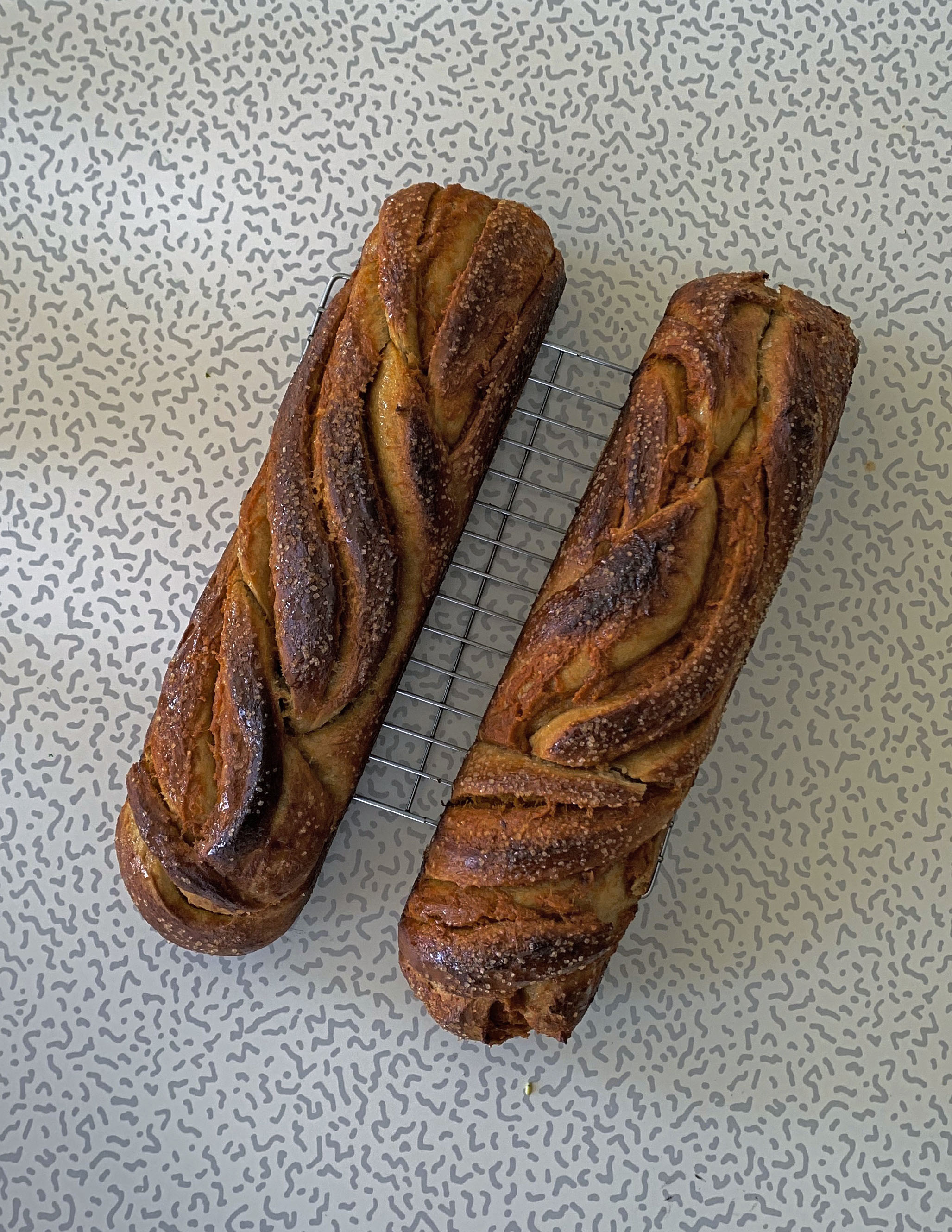CHALLAH HOWEVER YOU CAN
Yields 1 reasonably sized loaf
-I make everything by hand. You can use a mixer affixed with a dough hook if you’ve got one, but it’s not necessary.
-This recipe calls for milk but you can replace it with warm water for a more traditional (and kosher) challah.
-For ease and breadth of use, the recipe is written with commercial yeast. If you only have active dry yeast instead of instant, let the milk/warm water cool, then combine with half the honey and let the yeast bloom in the mixture before adding to the rest of the ingredients. If you have access to sourdough, replace the yeast with a portion of active starter, 30% of the flour weight (145g for a single batch as written below), and rest dough overnight in the fridge after initial rise in the bowl. After shaping, you’ll need to add an hour or two onto the final proofing stage. Otherwise, proceed as written.
-Suggestion for a moister, more playful bread: layer in fillings, sweet and/or savory, anything you have on hand. Pureed roasted sweet potato with a bit of maple, cardamom, salt and an egg yolk is a good place to start. Roll the dough out into a rectangle an inch thick, smear with 2 or 3 sweet potatoes worth of seasoned mash, roll up in a log, cut in half vertically, twist the pieces together into a rope, bake as written. INGREDIENTS
120g scalded milk, a bit more as needed during mix (or water, see notes)
70g honey
75g oil (olive oil, canola, etc.)
2 large eggs (120g)
480g all purpose flour
8g (1 Tbsp) instant yeast (see notes)
8g (1 1/2 tsp) salt
Egg wash:
1 egg sloshed with a dash of water
DIRECTIONSMix dry ingredients in a bowl. Set aside.
Combine all wet ingredients in a large bowl. Use your (clean) hands or a utensil to mix until homogenous. Add dry ingredients on top and begin kneading, moving the dough out of the bowl and onto the counter if it’s more pleasing for you to work there. I prefer to be able to really wrestle with it on a solid surface, then leave it be for a minute under an inverted bowl before returning and wrestling some more. This dough benefits from time spent alone and still (a teacher). Return to it after a few minutes away and you’ll notice much of the strengthening and smoothing has been done in your absence. Work the mass until it barely tears when you fold it over on itself. Lots of stretching and creasing, but don’t rip or pinch. No violence. Consider it like one whole body, not meant to be torn apart. If the dough feels very tight, add a bit of water, a tablespoon at a time. If its quite sticky, add a little flour. Use your head and your hands. They go well together.
Once the dough feels strong and relatively smooth, 5-10 mins of kneading or 20 of kneading and resting combined, form a tight ball, coat in a light layer of oil and rest in a bowl, covered, for an hour or two. It should grow but not feel precariously lofty. You can place in the fridge after an hour and shape the next day (improved flavor and texture), or continue to the next step immediately (more than good enough).
Return the dough to a clean countertop and lightly flatten with your hands. Use a bench knife to cut into a few pieces, 3-6 or whatever you feel like. Shape them into ropes by coaxing each piece into a rough rectangular shape and folding the edges in to create a middle seam. Press together, pinching and prodding lightly to maintain the new shape. Roll firmly, with strong flat hands like paddles, in charge, on a counter top, letting the dough rest for a few minutes if it is very springy and stubborn, and then continuing with all the pieces until you have ropes of relatively equal length. Braid together however you’d like, or just weave and loop at random. The bread doesn’t care, it’s not like you that way. Place on a parchment lined baking sheet and cover with a towel or a lightly oiled piece of plastic.
Let your shaped dough proof (rest, rise) for about an hour and a half or until it likes your poke i.e. doesn’t spring back, retaliate, when pushed. A fingerprint should fill in slowly. If the impression remains entirely you’ve waited too long, but bake it anyway. It’ll be fine and next time you may do better. About 30 minutes before you have a hunch it will be ready, preheat your oven to 375F.
Brush with egg wash and bake for about 20-30 minutes, or until a deep golden on top and bottom. Despite all its enrichments, challah can easily come out dry and distinctly un-worth-it, so, unlike many other bread recipes, avoid baking too dark.
Eat this the day it’s baked for peak performance, or slice up and freeze for extended pleasure. Alternatively, just leave on the counter and toast before eating, until its gone.

